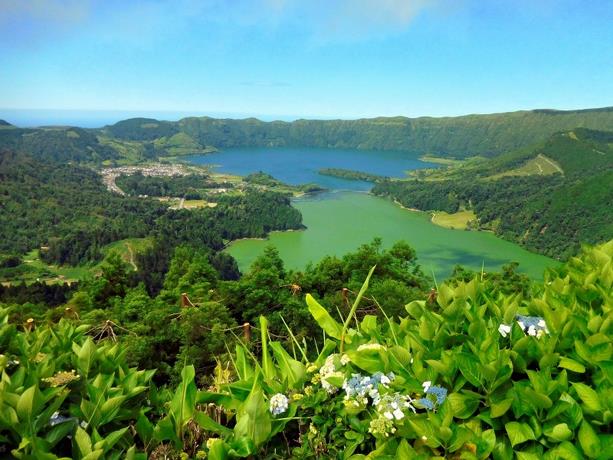In the middle of the North Atlantic and at a distance of 1,287 kilometers (800 miles) west of mainland Portugal, lies the Azores archipelago, a group of nine islands with about 250,000 inhabitants.
The Portuguese islands of Santa Maria, São Miguel, Terceira, Graciosa, São Jorge, Pico, Faial, Flores and Corvo boast volcanoes, blue hydrangeas, steep coastal cliffs, white sand beaches and countless natural beauties, filled with the immensity of the colors green and blue, and waiting to be explored.
Undoubtedly, nature is its strongest point.
“The nine islands that make up the Azores are, in fact, the peaks of some of the highest mountains, rising from the depths of the Atlantic. The once uninhabited volcanic archipelago now receives thousands of tourists each year who come to the island for its sun, sand and verdant mountain scenery. From the beaches of Praia da Vitoria and the bustling port of Horta to the bubbly "ovens" volcanoes of Furnas, these islands offer incomparable adventures yet to be discovered”, review Tripadvisor.
Santa Maria
“The green of the fields, the traditional cultures, the chimneys of the whitewashed houses, the dark ocher of the earth, the gold of the beaches and its turquoise blue waters” are what differentiate Santa María from the rest of the islands in the archipelago, according to the tourist information center Visit Portugal.
Santa María is further south and east than the rest, which makes it have the hottest and driest climate.
“The beaches are warm and with clear sand (Playa Formosa), and the vineyards that cover the slopes arranged in an amphitheater (San Lourenzo) remind us of stairs for giants,” he writes. VisitPortugal.
Sao Miguel
It is the largest of the islands and captivates with its Sete Cidades and Fogo lagoons. The force that emanates from the earth is felt in the geysers, hot springs and volcanic lakes, as well as in the tasty “Furnas stew”, which is slowly cooked inside the earth.
Third
As its own name indicates, this was the third island of the archipelago to be discovered. “Terceira is one of the main entry points of the Azores, it forms together with the islands of Graciosa, São Jorge, Pico and Faial the central group of the archipelago”, indicates Visit Portugal.
What makes Terceira special is the magnificent contrast between the natural beauty of this volcanic island and the admirable work of man in the historic center of “Angra do Heroísmo”, its capital.
“Founded in 1534, it was the first town in the Azores elevated to city level and classified as a UNESCO World Heritage Site,” he points out. VisitPortugal.
funny
Classified by Unesco as a World Biosphere Reserve, it is the northernmost island of the five that make up the Central Group of the Azores archipelago.
The island has one municipality, Santa Cruz da Graciosa, made up of four parishes: Vila de Santa Cruz, Vila da Praia, Guadalupe and Luz.
“The Caldera de Graciosa is the most emblematic landscape element of this island,” he points out. VisitPortugal.
Sao Jorge
It is the island of escarpments, cliffs and fajãs, one of the greenest in the Azores archipelago. This island, 54 kilometers long by 6.9 kilometers wide, belongs to the Central Group and is one of the vertices of the so-called “triangle islands”, along with Faial and Pico.
“While strolling around the island, you can admire the land parceled out for subsistence agriculture, the stone houses with three-leaf sash windows, the waterfalls, and the curious steel cables that are used to transport firewood to the coastal plains.” review Visit Portugal.
Peak
It is the second largest in the archipelago and where the highest mountain in Portugal is located.
The wide lava fields that mark the landscape of the island and which the local population calls lajidos or terras de biscoito form the Pico Island Vineyard Cultivation Landscape, declared a World Heritage Site by Unesco in 2004. Between Among them, it is worth highlighting the sites of Lajido da Criação Velha and Lajido de Santa Luzia.
Faial
Faial is located in the central group of the Azores archipelago and is part of the so-called “triangle islands”, along with São Jorge and the neighboring island of Pico, separated by the Canal do Faial, a narrow arm of the sea about 8 kilometers wide.
“Faial is the cool blue of hydrangeas, the marina colored by the paintings of sailors from all over the world and the Capelinhos volcano, now inactive, reminiscent of a lunar landscape”, says VisitPortugal.
Flowers
It is in the westernmost territory of the Azores and Europe, and has landscapes that are true paradises.
Flores is full of colorful flowers, hence its name, marked by waterfalls, lagoons, rivers and wells.
Due to its small dimensions it is not difficult to explore the entire island. It is integrated into the world network of Unesco Biosphere Reserves.
crooked
It is the smallest of the islands. It has a wide and beautiful caldera in its center and attracts several species of birds that come not only from the European continent, but also from the American continent.
Corvo Island, considered a World Biosphere Reserve by Unesco, forms together with Flores Island the western group of the Azores archipelago.
